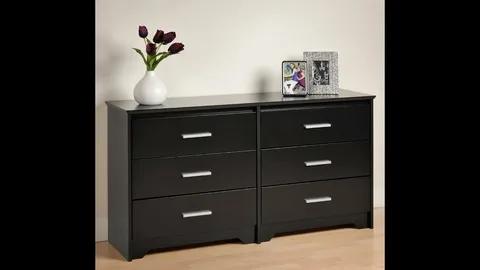
Solid Wood vs. Veneer Dressers: What’s the Price Difference?
When shopping for a dresser, you'll likely encounter two primary options in terms of construction: solid wood and wood veneer. While they might appear similar at first glance, their pricing, durability, and long-term value vary significantly. Choosing the right dresser type depends on your priorities—whether you value longevity, aesthetics, or budget-friendliness. Both types have their place in the market and offer distinct advantages. But if you're wondering what justifies a higher price tag or a surprisingly low one, this guide will help you understand the core differences. One of the first things shoppers tend to notice is the wide fluctuation in Dressers price in United States, which is often tied directly to whether a piece is made of solid wood or veneer.
What Is a Solid Wood Dresser?
Solid wood dressers are crafted entirely from planks of real wood—be it oak, maple, walnut, cherry, or even pine. These types of dressers are known for their exceptional durability, timeless appearance, and high resale value. Solid wood furniture is often passed down through generations and can be refinished or repaired as needed.
Pros of Solid Wood Dressers:
-
Longevity: With proper care, they can last several decades.
-
Natural Beauty: Wood grain patterns are unique and aesthetically pleasing.
-
Structural Integrity: These dressers are less prone to sagging or structural issues over time.
-
Restoration Friendly: Scratches, dents, or blemishes can be sanded and refinished easily.
Cons of Solid Wood Dressers:
-
Cost: Solid wood is more expensive due to material and labor costs.
-
Weight: Heavier than other options, making it harder to move.
-
Climate Sensitive: Susceptible to warping or expansion in extreme humidity.
What Is a Veneer Dresser?
A veneer dresser is typically made with a core of particle board, MDF, or plywood and covered with a thin slice of real wood (the veneer). This allows for a wood-like appearance at a lower cost. Veneer furniture can be highly attractive and functional, but it has limitations in terms of durability and repairability.
Pros of Veneer Dressers:
-
Affordable: Offers the look of wood without the price tag.
-
Lightweight: Easier to transport and rearrange.
-
Sustainable Options: Uses less hardwood, making it an environmentally friendly choice.
-
Aesthetic Variety: Veneers allow for consistent grain patterns and modern finishes.
Cons of Veneer Dressers:
-
Durability: Less long-lasting than solid wood.
-
Limited Repairability: Veneers can chip or peel and are difficult to refinish.
-
Water Sensitivity: Core materials may swell if exposed to moisture.
Price Comparison: Solid Wood vs. Veneer
Understanding the cost implications of each type can help guide your decision. Here's a general idea of how pricing differs:
-
Solid Wood Dressers: $700 – $2,500 or more, depending on wood type and craftsmanship.
-
Veneer Dressers: $200 – $800, varying by brand, quality, and finish.
The significant price difference stems from the cost of raw materials, the complexity of construction, and the labor involved in crafting solid wood furniture. Veneer dressers are often mass-produced and more accessible for budget-conscious buyers.
Quality Indicators to Watch For
When shopping, it’s not just about whether a dresser is labeled “solid wood” or “veneer.” Quality varies within each category. Look for these indicators:
-
Joinery: Dovetail joints are a sign of quality craftsmanship in both types.
-
Finish: High-end veneer pieces may have multi-layer lacquer finishes for durability.
-
Hardware: Solid metal handles and smooth-gliding drawers indicate attention to detail.
If you want a complete picture of market trends, researching average Dressers prices in United States gives you a better sense of what to expect based on style and material.
FAQs
1. Is solid wood always worth the higher price?
If you're looking for a long-term investment and plan to use the dresser for many years or even pass it down, solid wood is well worth the price.
2. Can veneer dressers look just as good as solid wood ones?
Absolutely. Modern veneers are often indistinguishable from solid wood in appearance, especially when professionally finished.
3. Which is better for resale value?
Solid wood typically holds more value over time. Well-maintained pieces can even increase in worth, particularly vintage or antique styles.
4. Are veneer dressers a good option for rental properties?
Yes. They're more affordable, stylish, and lightweight—perfect for shorter-term use and spaces that might see frequent changes in tenants.
5. How can I tell if a dresser is solid wood or veneer?
Check the edges and undersides of drawers. Solid wood usually shows consistent grain patterns throughout, while veneer often reveals a layered look or a different core material inside.
Conclusion
When it comes to choosing between solid wood and veneer dressers, the decision boils down to your priorities. Solid wood offers durability, prestige, and the potential for long-term savings, while veneer dressers give you style and practicality at a fraction of the cost. Both types have their own merits and serve different needs. If you’re on the hunt for a great deal, My Signature Home Furniture is one of the best places for the lowest Dressers prices in United States. From classic solid wood designs to contemporary veneer finishes, you'll find options that blend quality with affordability for every room in your home.
